Selling an online course or digital product requires more than just a well-designed landing page. To reach the right people, at the right time, with the right message, Facebook Ads offer unmatched precision. With over 3 billion monthly active users on Facebook and Instagram, your target audience is already out there—you just need the tools to connect with them.
1. Set Clear Goals Before You Spend a Dime
Before launching your first ad campaign, define what you want to achieve:
-
Do you want course signups?
-
Are you validating a digital product idea?
-
Do you want to grow your email list for a future launch?
This clarity will guide your ad creatives, audience selection, and budget allocation.
2. Know Your Audience Inside Out
Effective Facebook advertising relies on strong audience insights. Define:
-
Age, gender, and location
-
Occupation or industry (especially relevant for B2B digital products)
-
Interests, behaviors, and online habits
Using LeadEnforce, you can create hyper-targeted custom audiences based on group memberships and page likes. This is invaluable when trying to reach niche groups like freelance marketers, coding bootcamp alumni, or health-conscious parents.
3. Choose the Right Campaign Objective
Sample Facebook Ads funnel benchmarks for education/digital‑course advertising campaigns (conversion rates, costs & return)
Facebook offers various ad objectives. For selling a digital product or course, consider:
-
Conversions: Track sales or signups on your site
-
Lead Generation: Capture email leads directly within Facebook
-
Traffic: Drive people to your landing page
Use the Facebook Pixel to measure performance and optimize ads based on real results.
4. Nail Your Ad Creatives
Average Facebook Ads cost per lead by ad format—Lead‑form ads outperform image, carousel and video formats in lead‑gen cost
Your creatives must resonate with your audience. Here are essentials for a successful ad:
-
Eye-catching image or video
-
Clear, benefit-driven headline
-
Specific call to action ("Enroll Now," "Download Free Guide")
-
Social proof like testimonials or course completions
Test multiple versions using A/B testing to identify what performs best.
5. Use Interest-Based Targeting
Interest-based targeting lets you reach users who are already engaging with topics related to your product. Based on keyword research, here are some effective interest categories for digital course promotion:
-
Online learning
-
E-learning
-
Personal development
-
Digital marketing
-
Entrepreneurship
-
Passive income
-
Graphic design
-
Small business
-
Coding
-
Fitness coaching
6. Build Custom Audiences for Retargeting
Most people don’t convert on the first visit. Use custom audiences to retarget:
-
Website visitors
-
Video viewers
-
Email subscribers
-
People who engaged with your Facebook page
You can even use Lookalike Audiences to find new users similar to your best customers.
7. Optimize and Scale
Start small, monitor performance daily, and double down on what works. Key metrics to track:
-
Click-through rate (CTR)
-
Cost per lead (CPL)
-
Conversion rate
-
Return on ad spend (ROAS)
Once you find winning ad sets, increase your budget or duplicate them to scale.
8. Don’t Skip the Follow-Up
Use email automation or messenger bots to nurture leads who didn’t buy right away. A typical digital course buyer may need 3-5 touchpoints before purchasing.
Final Thoughts
Facebook Ads can be a game-changer for selling digital products and online courses. With the right tools like LeadEnforce, you can target hyper-specific audiences, retarget non-converters, and scale winning campaigns with precision.

